Marketing Intelligence Report: Sainsbury's Market Research Analysis
VerifiedAdded on 2020/01/28
|18
|5159
|201
Report
AI Summary
This marketing intelligence report analyzes Sainsbury's, a UK-based retail firm, examining various aspects of its marketing strategy. The report begins by exploring the stages of the consumer decision-making process and buying behavior theories, including cognitive dissonance and diffusion of innovation, to understand how customers make purchasing decisions. It then delves into factors influencing buyer behavior, such as cultural, social, personal, psychological, and economic influences, and evaluates the relationship between brand loyalty, corporate image, and repeat purchasing. The report also outlines the objectives of market research, detailing various research techniques (primary and secondary) and the importance of data validity and reliability. Furthermore, it includes an assessment of Sainsbury's market size and trends, a competitor analysis, and a SWOT analysis to identify opportunities and threats. Finally, the report focuses on techniques for assessing consumer responses, designing a customer satisfaction survey, and reviewing its success, offering insights into improving customer satisfaction and overall market performance.
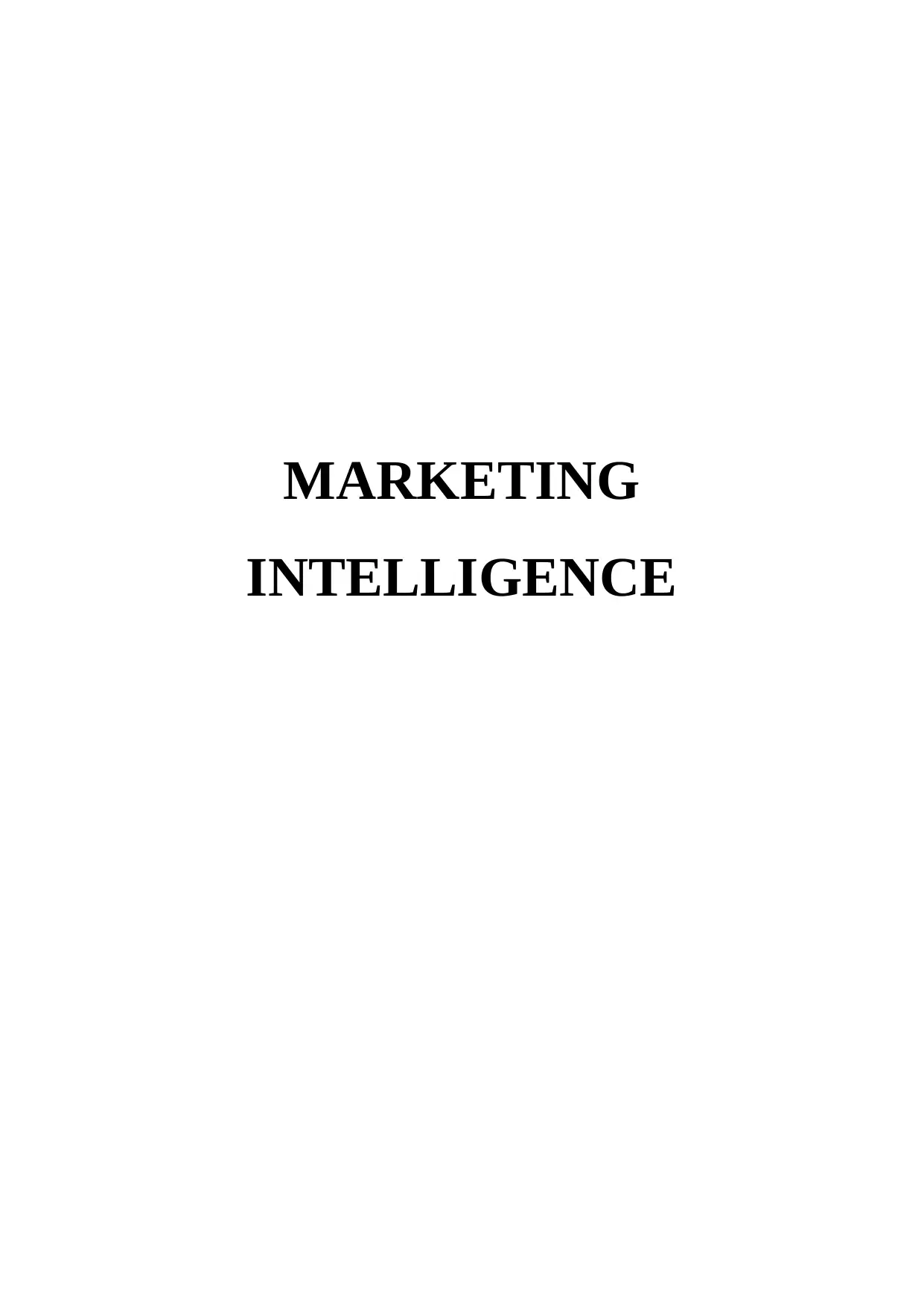
MARKETING
INTELLIGENCE
INTELLIGENCE
Paraphrase This Document
Need a fresh take? Get an instant paraphrase of this document with our AI Paraphraser
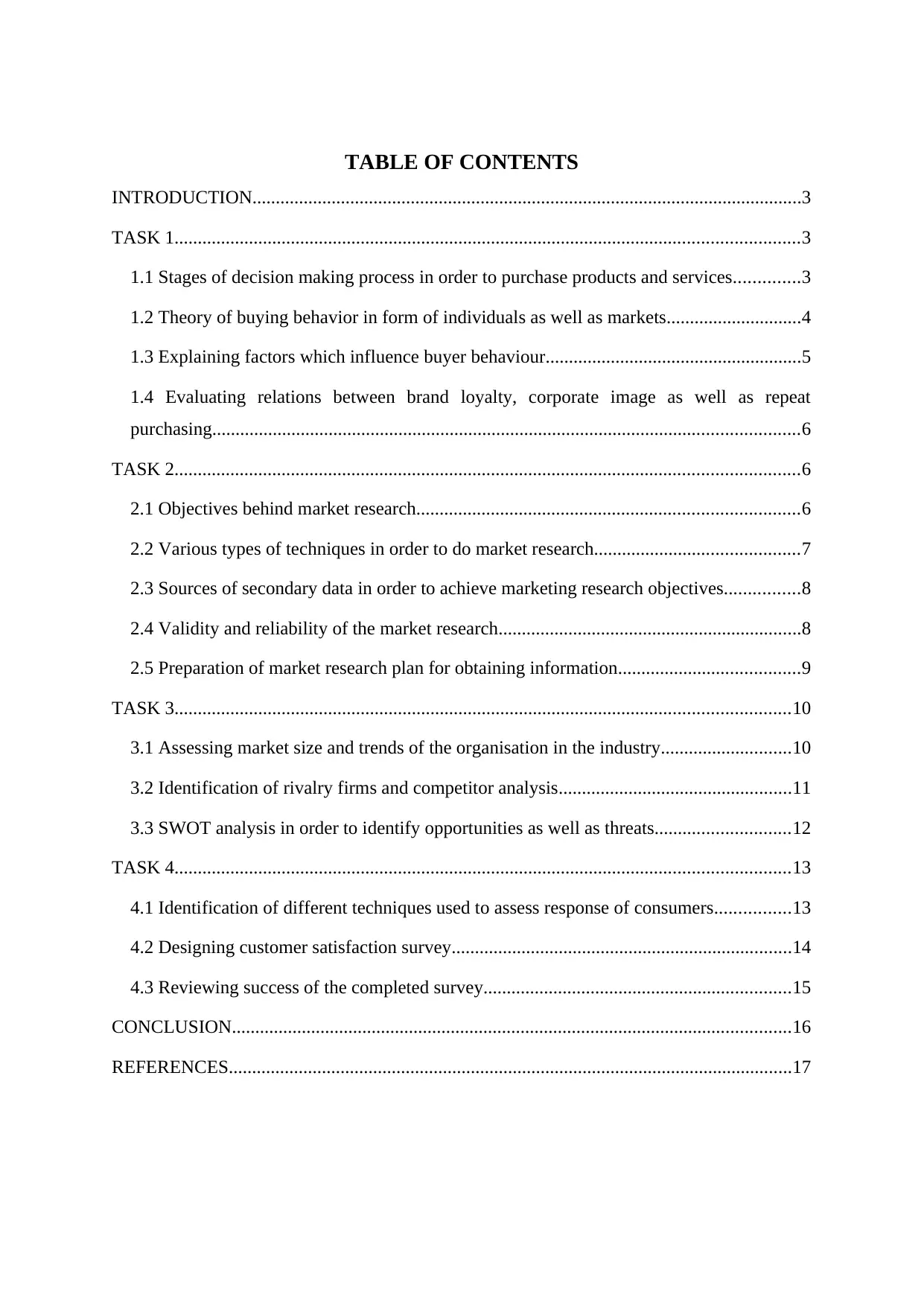
TABLE OF CONTENTS
INTRODUCTION......................................................................................................................3
TASK 1......................................................................................................................................3
1.1 Stages of decision making process in order to purchase products and services..............3
1.2 Theory of buying behavior in form of individuals as well as markets.............................4
1.3 Explaining factors which influence buyer behaviour.......................................................5
1.4 Evaluating relations between brand loyalty, corporate image as well as repeat
purchasing..............................................................................................................................6
TASK 2......................................................................................................................................6
2.1 Objectives behind market research..................................................................................6
2.2 Various types of techniques in order to do market research............................................7
2.3 Sources of secondary data in order to achieve marketing research objectives................8
2.4 Validity and reliability of the market research.................................................................8
2.5 Preparation of market research plan for obtaining information.......................................9
TASK 3....................................................................................................................................10
3.1 Assessing market size and trends of the organisation in the industry............................10
3.2 Identification of rivalry firms and competitor analysis..................................................11
3.3 SWOT analysis in order to identify opportunities as well as threats.............................12
TASK 4....................................................................................................................................13
4.1 Identification of different techniques used to assess response of consumers................13
4.2 Designing customer satisfaction survey.........................................................................14
4.3 Reviewing success of the completed survey..................................................................15
CONCLUSION........................................................................................................................16
REFERENCES.........................................................................................................................17
INTRODUCTION......................................................................................................................3
TASK 1......................................................................................................................................3
1.1 Stages of decision making process in order to purchase products and services..............3
1.2 Theory of buying behavior in form of individuals as well as markets.............................4
1.3 Explaining factors which influence buyer behaviour.......................................................5
1.4 Evaluating relations between brand loyalty, corporate image as well as repeat
purchasing..............................................................................................................................6
TASK 2......................................................................................................................................6
2.1 Objectives behind market research..................................................................................6
2.2 Various types of techniques in order to do market research............................................7
2.3 Sources of secondary data in order to achieve marketing research objectives................8
2.4 Validity and reliability of the market research.................................................................8
2.5 Preparation of market research plan for obtaining information.......................................9
TASK 3....................................................................................................................................10
3.1 Assessing market size and trends of the organisation in the industry............................10
3.2 Identification of rivalry firms and competitor analysis..................................................11
3.3 SWOT analysis in order to identify opportunities as well as threats.............................12
TASK 4....................................................................................................................................13
4.1 Identification of different techniques used to assess response of consumers................13
4.2 Designing customer satisfaction survey.........................................................................14
4.3 Reviewing success of the completed survey..................................................................15
CONCLUSION........................................................................................................................16
REFERENCES.........................................................................................................................17
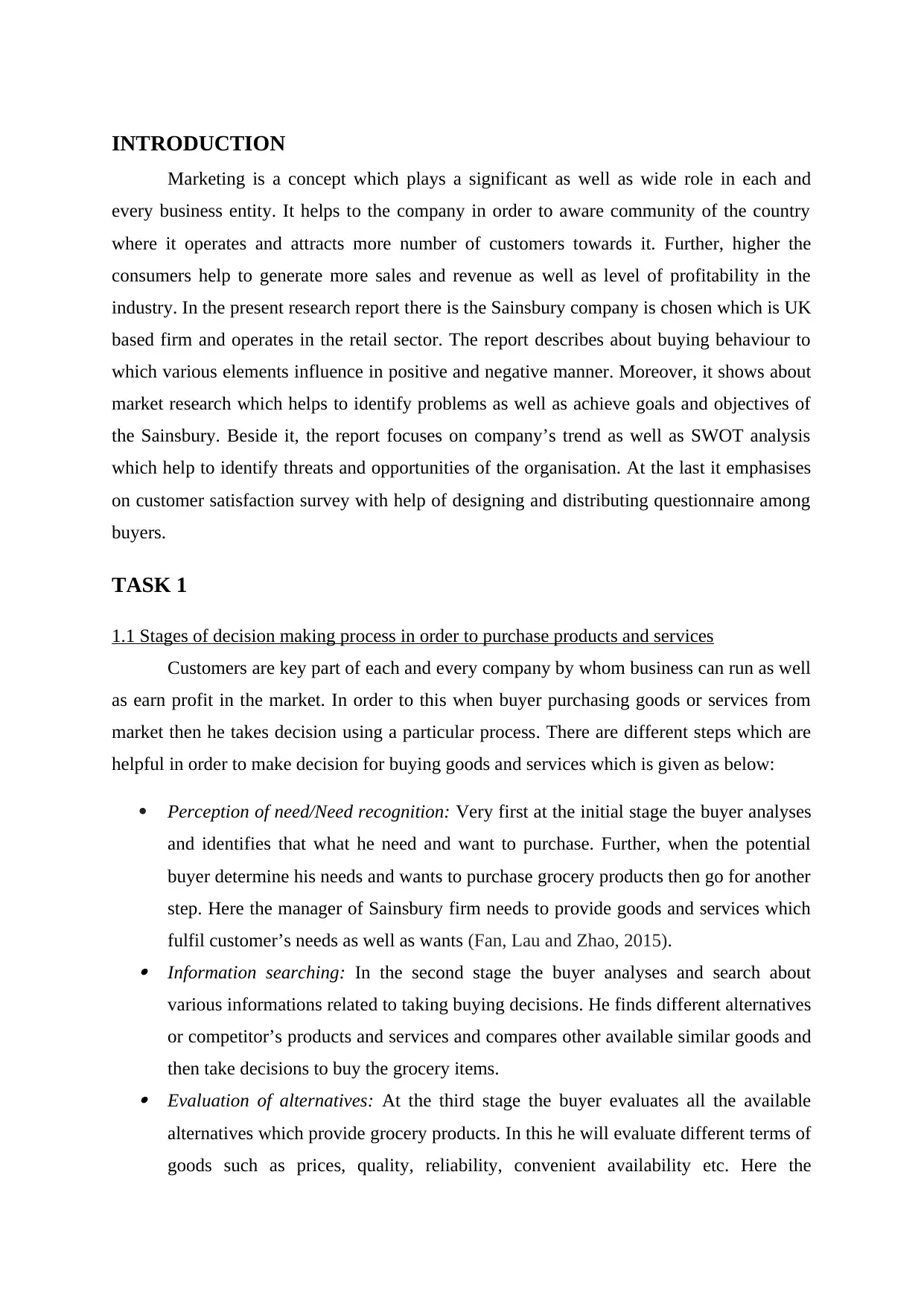
INTRODUCTION
Marketing is a concept which plays a significant as well as wide role in each and
every business entity. It helps to the company in order to aware community of the country
where it operates and attracts more number of customers towards it. Further, higher the
consumers help to generate more sales and revenue as well as level of profitability in the
industry. In the present research report there is the Sainsbury company is chosen which is UK
based firm and operates in the retail sector. The report describes about buying behaviour to
which various elements influence in positive and negative manner. Moreover, it shows about
market research which helps to identify problems as well as achieve goals and objectives of
the Sainsbury. Beside it, the report focuses on company’s trend as well as SWOT analysis
which help to identify threats and opportunities of the organisation. At the last it emphasises
on customer satisfaction survey with help of designing and distributing questionnaire among
buyers.
TASK 1
1.1 Stages of decision making process in order to purchase products and services
Customers are key part of each and every company by whom business can run as well
as earn profit in the market. In order to this when buyer purchasing goods or services from
market then he takes decision using a particular process. There are different steps which are
helpful in order to make decision for buying goods and services which is given as below:
Perception of need/Need recognition: Very first at the initial stage the buyer analyses
and identifies that what he need and want to purchase. Further, when the potential
buyer determine his needs and wants to purchase grocery products then go for another
step. Here the manager of Sainsbury firm needs to provide goods and services which
fulfil customer’s needs as well as wants (Fan, Lau and Zhao, 2015). Information searching: In the second stage the buyer analyses and search about
various informations related to taking buying decisions. He finds different alternatives
or competitor’s products and services and compares other available similar goods and
then take decisions to buy the grocery items. Evaluation of alternatives: At the third stage the buyer evaluates all the available
alternatives which provide grocery products. In this he will evaluate different terms of
goods such as prices, quality, reliability, convenient availability etc. Here the
Marketing is a concept which plays a significant as well as wide role in each and
every business entity. It helps to the company in order to aware community of the country
where it operates and attracts more number of customers towards it. Further, higher the
consumers help to generate more sales and revenue as well as level of profitability in the
industry. In the present research report there is the Sainsbury company is chosen which is UK
based firm and operates in the retail sector. The report describes about buying behaviour to
which various elements influence in positive and negative manner. Moreover, it shows about
market research which helps to identify problems as well as achieve goals and objectives of
the Sainsbury. Beside it, the report focuses on company’s trend as well as SWOT analysis
which help to identify threats and opportunities of the organisation. At the last it emphasises
on customer satisfaction survey with help of designing and distributing questionnaire among
buyers.
TASK 1
1.1 Stages of decision making process in order to purchase products and services
Customers are key part of each and every company by whom business can run as well
as earn profit in the market. In order to this when buyer purchasing goods or services from
market then he takes decision using a particular process. There are different steps which are
helpful in order to make decision for buying goods and services which is given as below:
Perception of need/Need recognition: Very first at the initial stage the buyer analyses
and identifies that what he need and want to purchase. Further, when the potential
buyer determine his needs and wants to purchase grocery products then go for another
step. Here the manager of Sainsbury firm needs to provide goods and services which
fulfil customer’s needs as well as wants (Fan, Lau and Zhao, 2015). Information searching: In the second stage the buyer analyses and search about
various informations related to taking buying decisions. He finds different alternatives
or competitor’s products and services and compares other available similar goods and
then take decisions to buy the grocery items. Evaluation of alternatives: At the third stage the buyer evaluates all the available
alternatives which provide grocery products. In this he will evaluate different terms of
goods such as prices, quality, reliability, convenient availability etc. Here the
⊘ This is a preview!⊘
Do you want full access?
Subscribe today to unlock all pages.

Trusted by 1+ million students worldwide
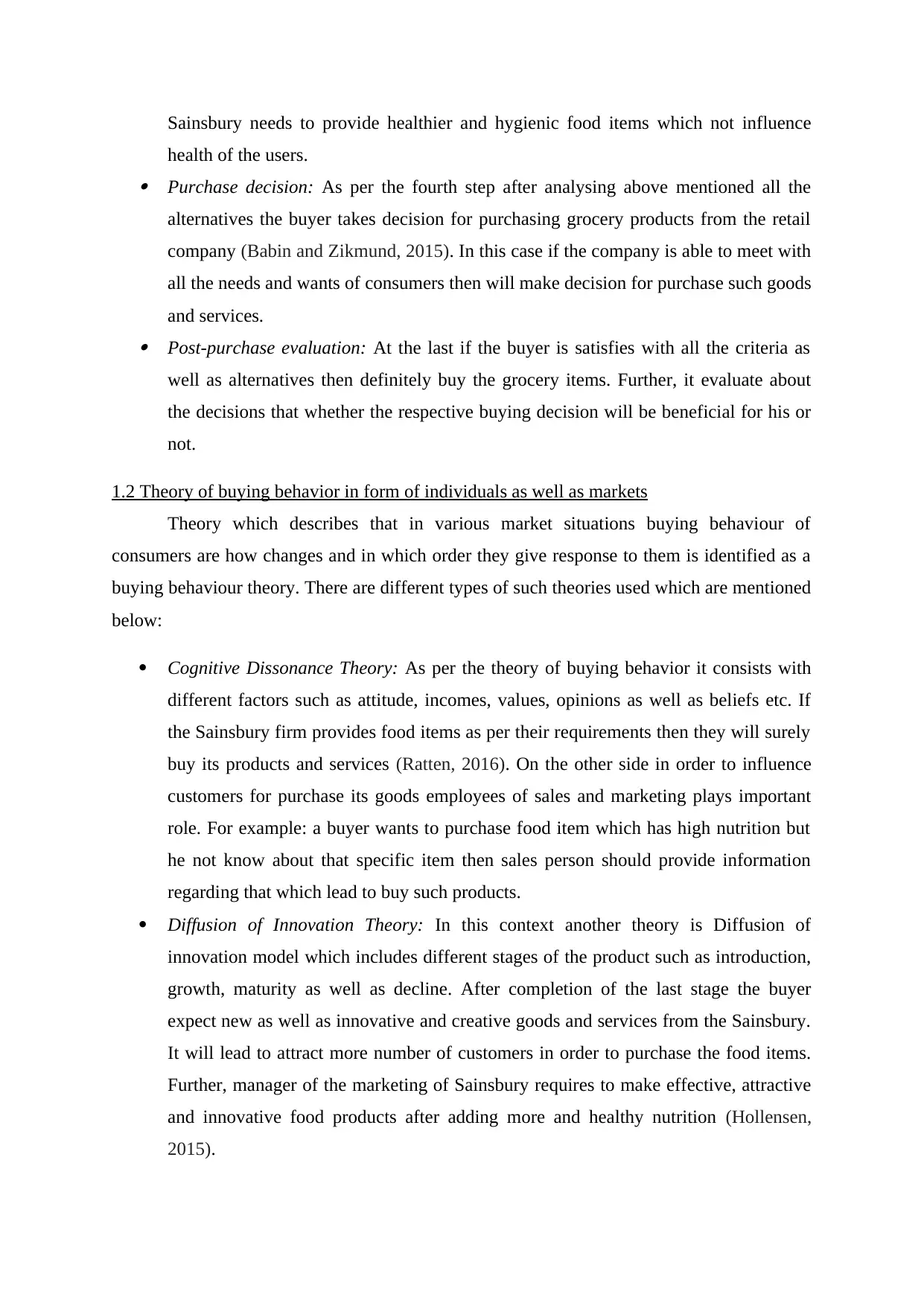
Sainsbury needs to provide healthier and hygienic food items which not influence
health of the users. Purchase decision: As per the fourth step after analysing above mentioned all the
alternatives the buyer takes decision for purchasing grocery products from the retail
company (Babin and Zikmund, 2015). In this case if the company is able to meet with
all the needs and wants of consumers then will make decision for purchase such goods
and services. Post-purchase evaluation: At the last if the buyer is satisfies with all the criteria as
well as alternatives then definitely buy the grocery items. Further, it evaluate about
the decisions that whether the respective buying decision will be beneficial for his or
not.
1.2 Theory of buying behavior in form of individuals as well as markets
Theory which describes that in various market situations buying behaviour of
consumers are how changes and in which order they give response to them is identified as a
buying behaviour theory. There are different types of such theories used which are mentioned
below:
Cognitive Dissonance Theory: As per the theory of buying behavior it consists with
different factors such as attitude, incomes, values, opinions as well as beliefs etc. If
the Sainsbury firm provides food items as per their requirements then they will surely
buy its products and services (Ratten, 2016). On the other side in order to influence
customers for purchase its goods employees of sales and marketing plays important
role. For example: a buyer wants to purchase food item which has high nutrition but
he not know about that specific item then sales person should provide information
regarding that which lead to buy such products.
Diffusion of Innovation Theory: In this context another theory is Diffusion of
innovation model which includes different stages of the product such as introduction,
growth, maturity as well as decline. After completion of the last stage the buyer
expect new as well as innovative and creative goods and services from the Sainsbury.
It will lead to attract more number of customers in order to purchase the food items.
Further, manager of the marketing of Sainsbury requires to make effective, attractive
and innovative food products after adding more and healthy nutrition (Hollensen,
2015).
health of the users. Purchase decision: As per the fourth step after analysing above mentioned all the
alternatives the buyer takes decision for purchasing grocery products from the retail
company (Babin and Zikmund, 2015). In this case if the company is able to meet with
all the needs and wants of consumers then will make decision for purchase such goods
and services. Post-purchase evaluation: At the last if the buyer is satisfies with all the criteria as
well as alternatives then definitely buy the grocery items. Further, it evaluate about
the decisions that whether the respective buying decision will be beneficial for his or
not.
1.2 Theory of buying behavior in form of individuals as well as markets
Theory which describes that in various market situations buying behaviour of
consumers are how changes and in which order they give response to them is identified as a
buying behaviour theory. There are different types of such theories used which are mentioned
below:
Cognitive Dissonance Theory: As per the theory of buying behavior it consists with
different factors such as attitude, incomes, values, opinions as well as beliefs etc. If
the Sainsbury firm provides food items as per their requirements then they will surely
buy its products and services (Ratten, 2016). On the other side in order to influence
customers for purchase its goods employees of sales and marketing plays important
role. For example: a buyer wants to purchase food item which has high nutrition but
he not know about that specific item then sales person should provide information
regarding that which lead to buy such products.
Diffusion of Innovation Theory: In this context another theory is Diffusion of
innovation model which includes different stages of the product such as introduction,
growth, maturity as well as decline. After completion of the last stage the buyer
expect new as well as innovative and creative goods and services from the Sainsbury.
It will lead to attract more number of customers in order to purchase the food items.
Further, manager of the marketing of Sainsbury requires to make effective, attractive
and innovative food products after adding more and healthy nutrition (Hollensen,
2015).
Paraphrase This Document
Need a fresh take? Get an instant paraphrase of this document with our AI Paraphraser
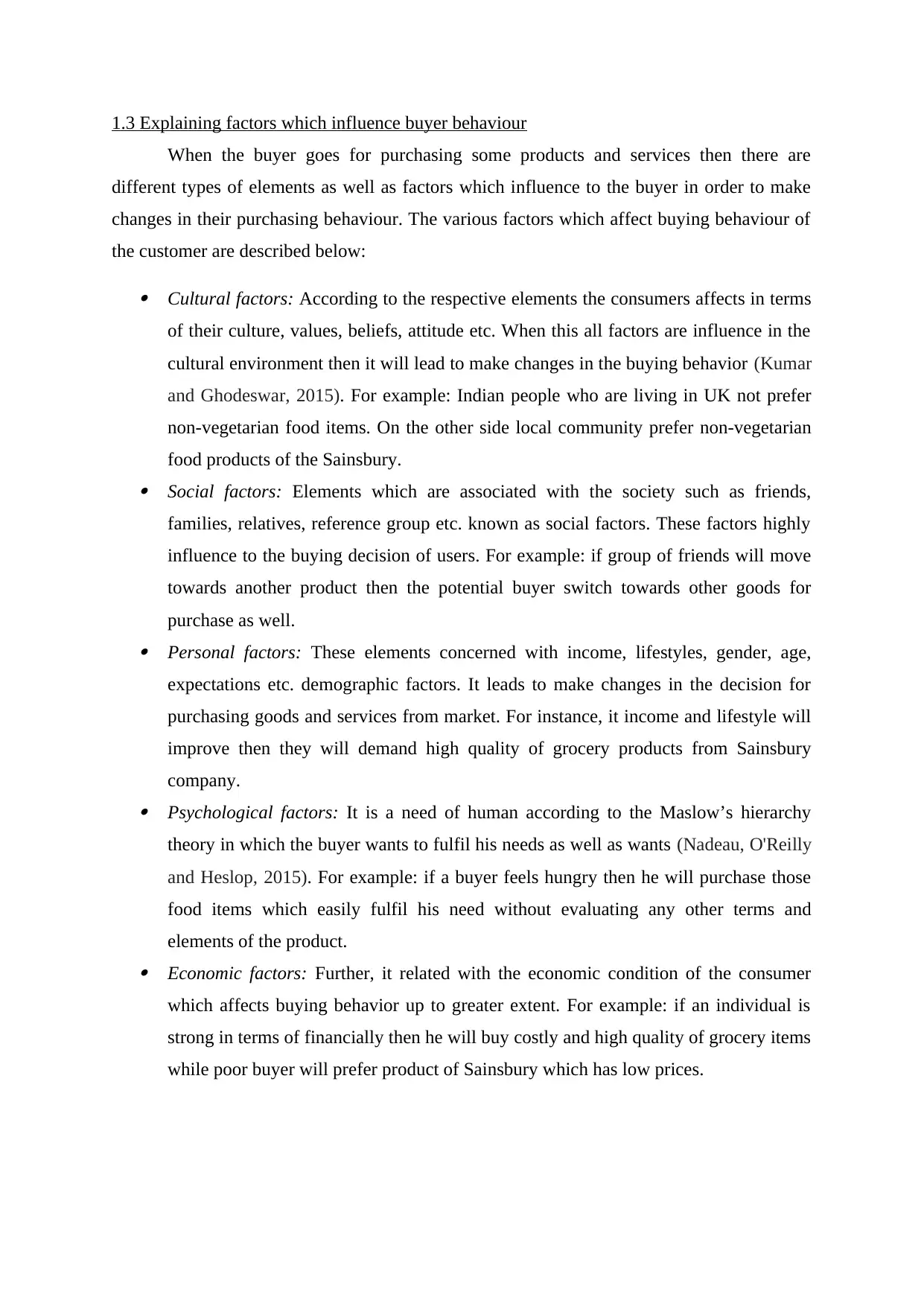
1.3 Explaining factors which influence buyer behaviour
When the buyer goes for purchasing some products and services then there are
different types of elements as well as factors which influence to the buyer in order to make
changes in their purchasing behaviour. The various factors which affect buying behaviour of
the customer are described below:
Cultural factors: According to the respective elements the consumers affects in terms
of their culture, values, beliefs, attitude etc. When this all factors are influence in the
cultural environment then it will lead to make changes in the buying behavior (Kumar
and Ghodeswar, 2015). For example: Indian people who are living in UK not prefer
non-vegetarian food items. On the other side local community prefer non-vegetarian
food products of the Sainsbury. Social factors: Elements which are associated with the society such as friends,
families, relatives, reference group etc. known as social factors. These factors highly
influence to the buying decision of users. For example: if group of friends will move
towards another product then the potential buyer switch towards other goods for
purchase as well. Personal factors: These elements concerned with income, lifestyles, gender, age,
expectations etc. demographic factors. It leads to make changes in the decision for
purchasing goods and services from market. For instance, it income and lifestyle will
improve then they will demand high quality of grocery products from Sainsbury
company. Psychological factors: It is a need of human according to the Maslow’s hierarchy
theory in which the buyer wants to fulfil his needs as well as wants (Nadeau, O'Reilly
and Heslop, 2015). For example: if a buyer feels hungry then he will purchase those
food items which easily fulfil his need without evaluating any other terms and
elements of the product. Economic factors: Further, it related with the economic condition of the consumer
which affects buying behavior up to greater extent. For example: if an individual is
strong in terms of financially then he will buy costly and high quality of grocery items
while poor buyer will prefer product of Sainsbury which has low prices.
When the buyer goes for purchasing some products and services then there are
different types of elements as well as factors which influence to the buyer in order to make
changes in their purchasing behaviour. The various factors which affect buying behaviour of
the customer are described below:
Cultural factors: According to the respective elements the consumers affects in terms
of their culture, values, beliefs, attitude etc. When this all factors are influence in the
cultural environment then it will lead to make changes in the buying behavior (Kumar
and Ghodeswar, 2015). For example: Indian people who are living in UK not prefer
non-vegetarian food items. On the other side local community prefer non-vegetarian
food products of the Sainsbury. Social factors: Elements which are associated with the society such as friends,
families, relatives, reference group etc. known as social factors. These factors highly
influence to the buying decision of users. For example: if group of friends will move
towards another product then the potential buyer switch towards other goods for
purchase as well. Personal factors: These elements concerned with income, lifestyles, gender, age,
expectations etc. demographic factors. It leads to make changes in the decision for
purchasing goods and services from market. For instance, it income and lifestyle will
improve then they will demand high quality of grocery products from Sainsbury
company. Psychological factors: It is a need of human according to the Maslow’s hierarchy
theory in which the buyer wants to fulfil his needs as well as wants (Nadeau, O'Reilly
and Heslop, 2015). For example: if a buyer feels hungry then he will purchase those
food items which easily fulfil his need without evaluating any other terms and
elements of the product. Economic factors: Further, it related with the economic condition of the consumer
which affects buying behavior up to greater extent. For example: if an individual is
strong in terms of financially then he will buy costly and high quality of grocery items
while poor buyer will prefer product of Sainsbury which has low prices.
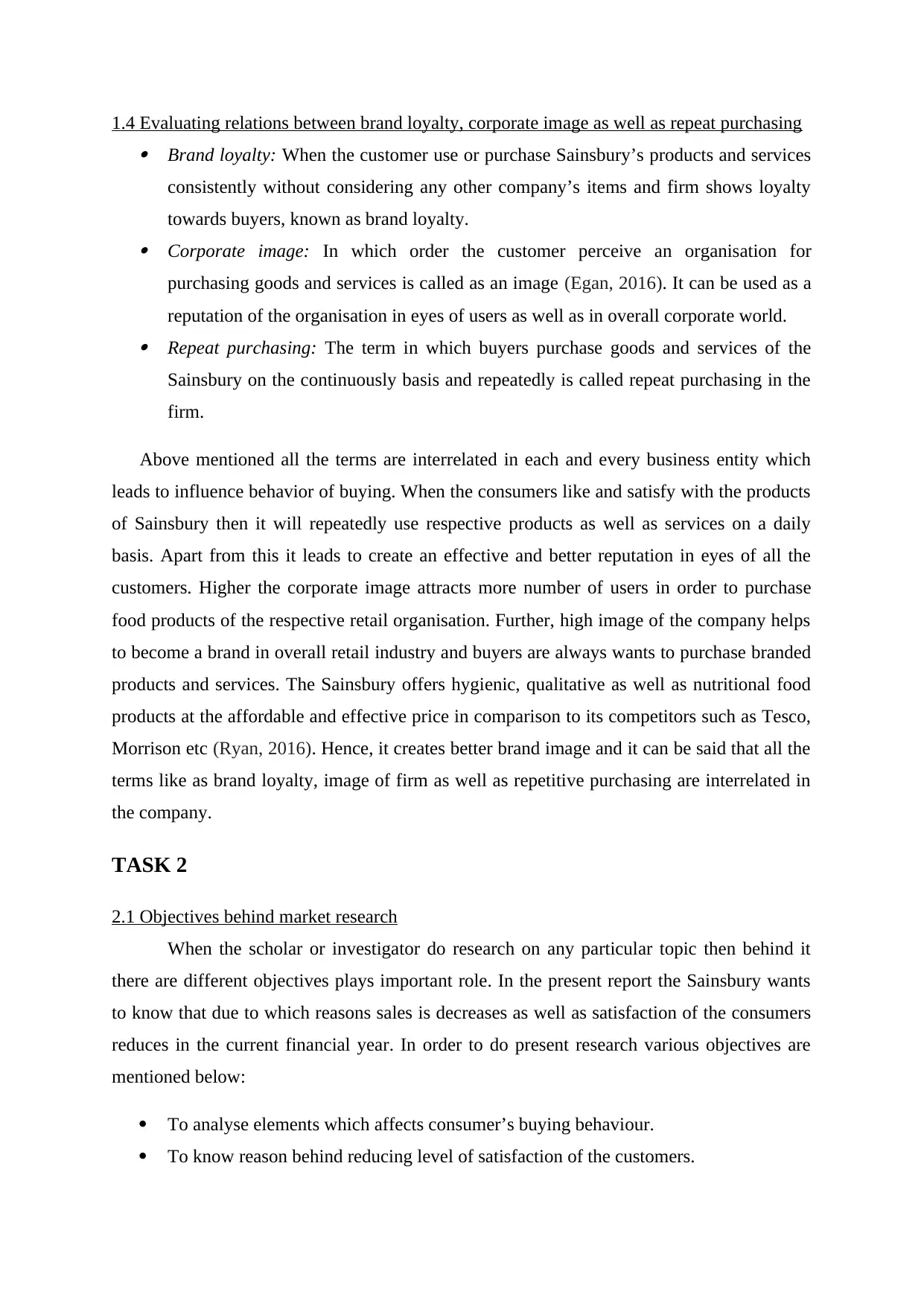
1.4 Evaluating relations between brand loyalty, corporate image as well as repeat purchasing Brand loyalty: When the customer use or purchase Sainsbury’s products and services
consistently without considering any other company’s items and firm shows loyalty
towards buyers, known as brand loyalty. Corporate image: In which order the customer perceive an organisation for
purchasing goods and services is called as an image (Egan, 2016). It can be used as a
reputation of the organisation in eyes of users as well as in overall corporate world. Repeat purchasing: The term in which buyers purchase goods and services of the
Sainsbury on the continuously basis and repeatedly is called repeat purchasing in the
firm.
Above mentioned all the terms are interrelated in each and every business entity which
leads to influence behavior of buying. When the consumers like and satisfy with the products
of Sainsbury then it will repeatedly use respective products as well as services on a daily
basis. Apart from this it leads to create an effective and better reputation in eyes of all the
customers. Higher the corporate image attracts more number of users in order to purchase
food products of the respective retail organisation. Further, high image of the company helps
to become a brand in overall retail industry and buyers are always wants to purchase branded
products and services. The Sainsbury offers hygienic, qualitative as well as nutritional food
products at the affordable and effective price in comparison to its competitors such as Tesco,
Morrison etc (Ryan, 2016). Hence, it creates better brand image and it can be said that all the
terms like as brand loyalty, image of firm as well as repetitive purchasing are interrelated in
the company.
TASK 2
2.1 Objectives behind market research
When the scholar or investigator do research on any particular topic then behind it
there are different objectives plays important role. In the present report the Sainsbury wants
to know that due to which reasons sales is decreases as well as satisfaction of the consumers
reduces in the current financial year. In order to do present research various objectives are
mentioned below:
To analyse elements which affects consumer’s buying behaviour.
To know reason behind reducing level of satisfaction of the customers.
consistently without considering any other company’s items and firm shows loyalty
towards buyers, known as brand loyalty. Corporate image: In which order the customer perceive an organisation for
purchasing goods and services is called as an image (Egan, 2016). It can be used as a
reputation of the organisation in eyes of users as well as in overall corporate world. Repeat purchasing: The term in which buyers purchase goods and services of the
Sainsbury on the continuously basis and repeatedly is called repeat purchasing in the
firm.
Above mentioned all the terms are interrelated in each and every business entity which
leads to influence behavior of buying. When the consumers like and satisfy with the products
of Sainsbury then it will repeatedly use respective products as well as services on a daily
basis. Apart from this it leads to create an effective and better reputation in eyes of all the
customers. Higher the corporate image attracts more number of users in order to purchase
food products of the respective retail organisation. Further, high image of the company helps
to become a brand in overall retail industry and buyers are always wants to purchase branded
products and services. The Sainsbury offers hygienic, qualitative as well as nutritional food
products at the affordable and effective price in comparison to its competitors such as Tesco,
Morrison etc (Ryan, 2016). Hence, it creates better brand image and it can be said that all the
terms like as brand loyalty, image of firm as well as repetitive purchasing are interrelated in
the company.
TASK 2
2.1 Objectives behind market research
When the scholar or investigator do research on any particular topic then behind it
there are different objectives plays important role. In the present report the Sainsbury wants
to know that due to which reasons sales is decreases as well as satisfaction of the consumers
reduces in the current financial year. In order to do present research various objectives are
mentioned below:
To analyse elements which affects consumer’s buying behaviour.
To know reason behind reducing level of satisfaction of the customers.
⊘ This is a preview!⊘
Do you want full access?
Subscribe today to unlock all pages.

Trusted by 1+ million students worldwide
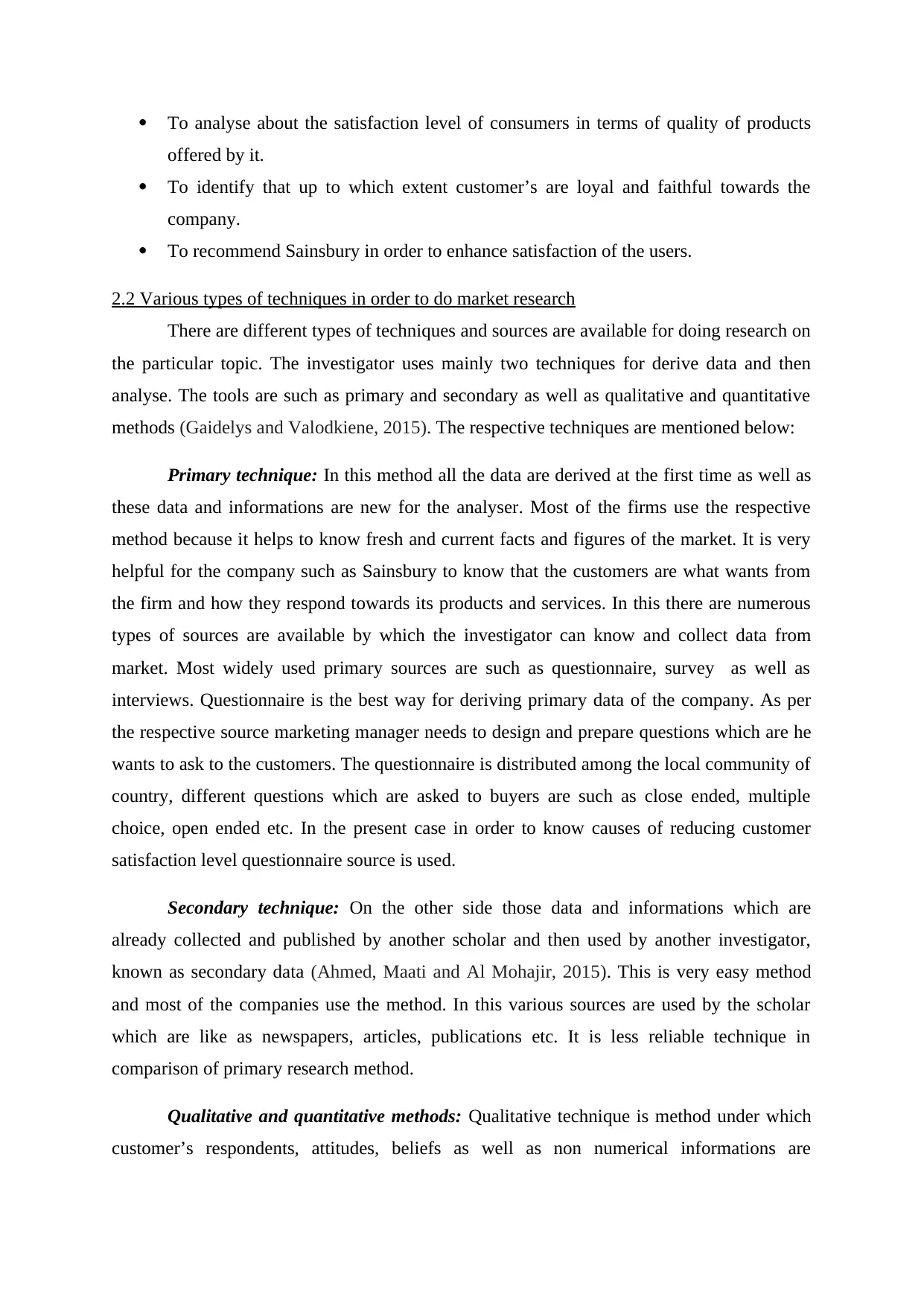
To analyse about the satisfaction level of consumers in terms of quality of products
offered by it.
To identify that up to which extent customer’s are loyal and faithful towards the
company.
To recommend Sainsbury in order to enhance satisfaction of the users.
2.2 Various types of techniques in order to do market research
There are different types of techniques and sources are available for doing research on
the particular topic. The investigator uses mainly two techniques for derive data and then
analyse. The tools are such as primary and secondary as well as qualitative and quantitative
methods (Gaidelys and Valodkiene, 2015). The respective techniques are mentioned below:
Primary technique: In this method all the data are derived at the first time as well as
these data and informations are new for the analyser. Most of the firms use the respective
method because it helps to know fresh and current facts and figures of the market. It is very
helpful for the company such as Sainsbury to know that the customers are what wants from
the firm and how they respond towards its products and services. In this there are numerous
types of sources are available by which the investigator can know and collect data from
market. Most widely used primary sources are such as questionnaire, survey as well as
interviews. Questionnaire is the best way for deriving primary data of the company. As per
the respective source marketing manager needs to design and prepare questions which are he
wants to ask to the customers. The questionnaire is distributed among the local community of
country, different questions which are asked to buyers are such as close ended, multiple
choice, open ended etc. In the present case in order to know causes of reducing customer
satisfaction level questionnaire source is used.
Secondary technique: On the other side those data and informations which are
already collected and published by another scholar and then used by another investigator,
known as secondary data (Ahmed, Maati and Al Mohajir, 2015). This is very easy method
and most of the companies use the method. In this various sources are used by the scholar
which are like as newspapers, articles, publications etc. It is less reliable technique in
comparison of primary research method.
Qualitative and quantitative methods: Qualitative technique is method under which
customer’s respondents, attitudes, beliefs as well as non numerical informations are
offered by it.
To identify that up to which extent customer’s are loyal and faithful towards the
company.
To recommend Sainsbury in order to enhance satisfaction of the users.
2.2 Various types of techniques in order to do market research
There are different types of techniques and sources are available for doing research on
the particular topic. The investigator uses mainly two techniques for derive data and then
analyse. The tools are such as primary and secondary as well as qualitative and quantitative
methods (Gaidelys and Valodkiene, 2015). The respective techniques are mentioned below:
Primary technique: In this method all the data are derived at the first time as well as
these data and informations are new for the analyser. Most of the firms use the respective
method because it helps to know fresh and current facts and figures of the market. It is very
helpful for the company such as Sainsbury to know that the customers are what wants from
the firm and how they respond towards its products and services. In this there are numerous
types of sources are available by which the investigator can know and collect data from
market. Most widely used primary sources are such as questionnaire, survey as well as
interviews. Questionnaire is the best way for deriving primary data of the company. As per
the respective source marketing manager needs to design and prepare questions which are he
wants to ask to the customers. The questionnaire is distributed among the local community of
country, different questions which are asked to buyers are such as close ended, multiple
choice, open ended etc. In the present case in order to know causes of reducing customer
satisfaction level questionnaire source is used.
Secondary technique: On the other side those data and informations which are
already collected and published by another scholar and then used by another investigator,
known as secondary data (Ahmed, Maati and Al Mohajir, 2015). This is very easy method
and most of the companies use the method. In this various sources are used by the scholar
which are like as newspapers, articles, publications etc. It is less reliable technique in
comparison of primary research method.
Qualitative and quantitative methods: Qualitative technique is method under which
customer’s respondents, attitudes, beliefs as well as non numerical informations are
Paraphrase This Document
Need a fresh take? Get an instant paraphrase of this document with our AI Paraphraser
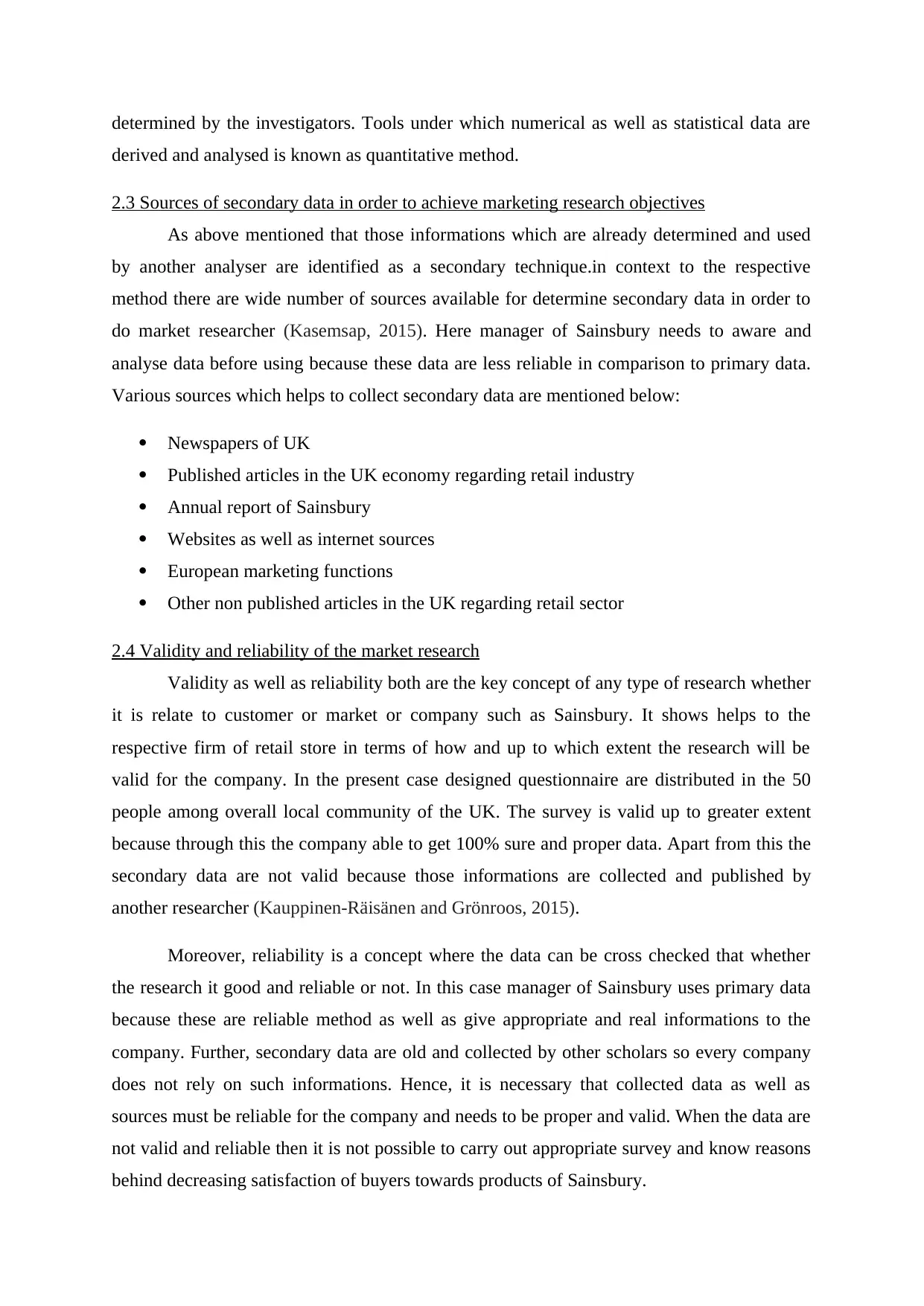
determined by the investigators. Tools under which numerical as well as statistical data are
derived and analysed is known as quantitative method.
2.3 Sources of secondary data in order to achieve marketing research objectives
As above mentioned that those informations which are already determined and used
by another analyser are identified as a secondary technique.in context to the respective
method there are wide number of sources available for determine secondary data in order to
do market researcher (Kasemsap, 2015). Here manager of Sainsbury needs to aware and
analyse data before using because these data are less reliable in comparison to primary data.
Various sources which helps to collect secondary data are mentioned below:
Newspapers of UK
Published articles in the UK economy regarding retail industry
Annual report of Sainsbury
Websites as well as internet sources
European marketing functions
Other non published articles in the UK regarding retail sector
2.4 Validity and reliability of the market research
Validity as well as reliability both are the key concept of any type of research whether
it is relate to customer or market or company such as Sainsbury. It shows helps to the
respective firm of retail store in terms of how and up to which extent the research will be
valid for the company. In the present case designed questionnaire are distributed in the 50
people among overall local community of the UK. The survey is valid up to greater extent
because through this the company able to get 100% sure and proper data. Apart from this the
secondary data are not valid because those informations are collected and published by
another researcher (Kauppinen-Räisänen and Grönroos, 2015).
Moreover, reliability is a concept where the data can be cross checked that whether
the research it good and reliable or not. In this case manager of Sainsbury uses primary data
because these are reliable method as well as give appropriate and real informations to the
company. Further, secondary data are old and collected by other scholars so every company
does not rely on such informations. Hence, it is necessary that collected data as well as
sources must be reliable for the company and needs to be proper and valid. When the data are
not valid and reliable then it is not possible to carry out appropriate survey and know reasons
behind decreasing satisfaction of buyers towards products of Sainsbury.
derived and analysed is known as quantitative method.
2.3 Sources of secondary data in order to achieve marketing research objectives
As above mentioned that those informations which are already determined and used
by another analyser are identified as a secondary technique.in context to the respective
method there are wide number of sources available for determine secondary data in order to
do market researcher (Kasemsap, 2015). Here manager of Sainsbury needs to aware and
analyse data before using because these data are less reliable in comparison to primary data.
Various sources which helps to collect secondary data are mentioned below:
Newspapers of UK
Published articles in the UK economy regarding retail industry
Annual report of Sainsbury
Websites as well as internet sources
European marketing functions
Other non published articles in the UK regarding retail sector
2.4 Validity and reliability of the market research
Validity as well as reliability both are the key concept of any type of research whether
it is relate to customer or market or company such as Sainsbury. It shows helps to the
respective firm of retail store in terms of how and up to which extent the research will be
valid for the company. In the present case designed questionnaire are distributed in the 50
people among overall local community of the UK. The survey is valid up to greater extent
because through this the company able to get 100% sure and proper data. Apart from this the
secondary data are not valid because those informations are collected and published by
another researcher (Kauppinen-Räisänen and Grönroos, 2015).
Moreover, reliability is a concept where the data can be cross checked that whether
the research it good and reliable or not. In this case manager of Sainsbury uses primary data
because these are reliable method as well as give appropriate and real informations to the
company. Further, secondary data are old and collected by other scholars so every company
does not rely on such informations. Hence, it is necessary that collected data as well as
sources must be reliable for the company and needs to be proper and valid. When the data are
not valid and reliable then it is not possible to carry out appropriate survey and know reasons
behind decreasing satisfaction of buyers towards products of Sainsbury.
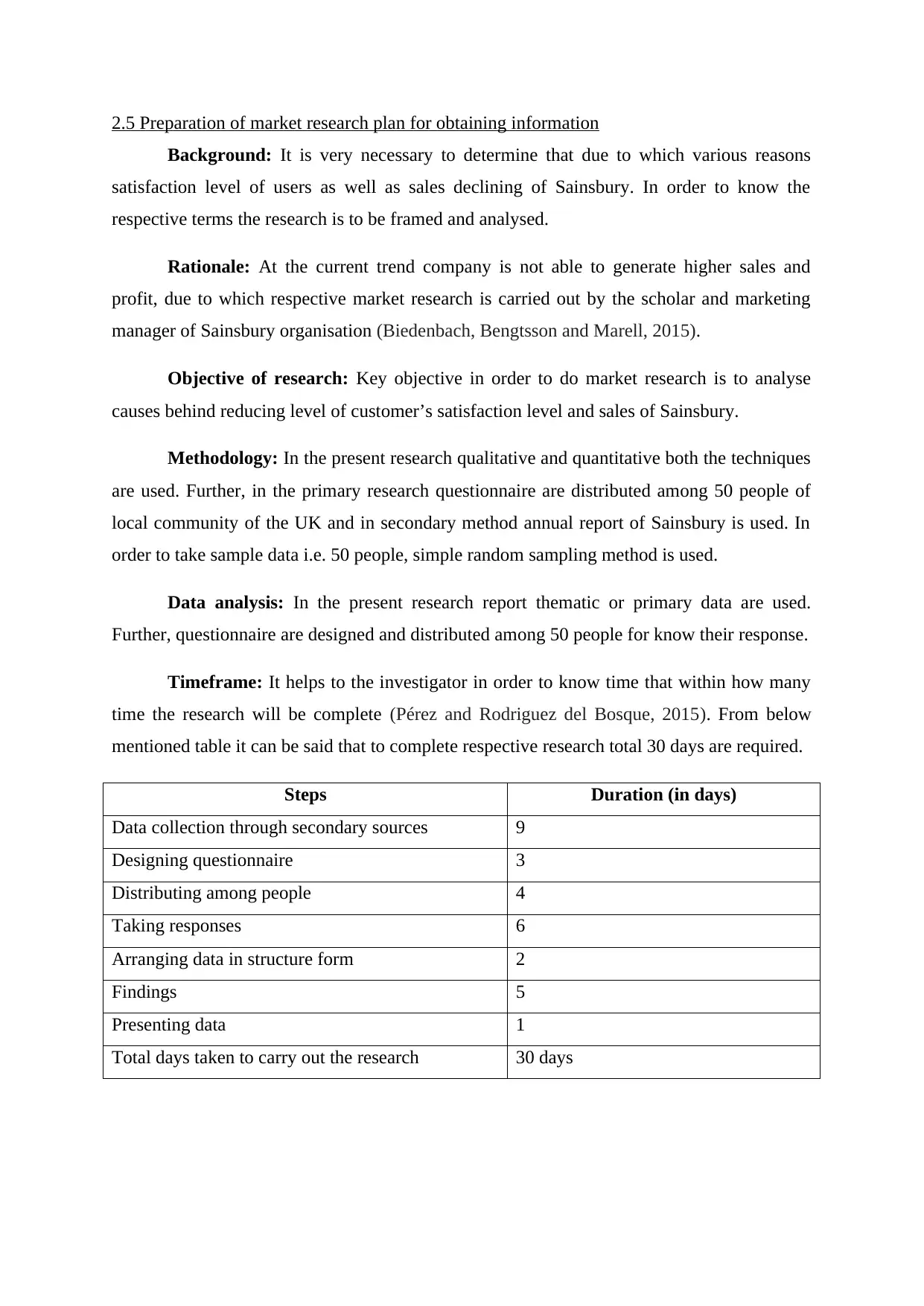
2.5 Preparation of market research plan for obtaining information
Background: It is very necessary to determine that due to which various reasons
satisfaction level of users as well as sales declining of Sainsbury. In order to know the
respective terms the research is to be framed and analysed.
Rationale: At the current trend company is not able to generate higher sales and
profit, due to which respective market research is carried out by the scholar and marketing
manager of Sainsbury organisation (Biedenbach, Bengtsson and Marell, 2015).
Objective of research: Key objective in order to do market research is to analyse
causes behind reducing level of customer’s satisfaction level and sales of Sainsbury.
Methodology: In the present research qualitative and quantitative both the techniques
are used. Further, in the primary research questionnaire are distributed among 50 people of
local community of the UK and in secondary method annual report of Sainsbury is used. In
order to take sample data i.e. 50 people, simple random sampling method is used.
Data analysis: In the present research report thematic or primary data are used.
Further, questionnaire are designed and distributed among 50 people for know their response.
Timeframe: It helps to the investigator in order to know time that within how many
time the research will be complete (Pérez and Rodriguez del Bosque, 2015). From below
mentioned table it can be said that to complete respective research total 30 days are required.
Steps Duration (in days)
Data collection through secondary sources 9
Designing questionnaire 3
Distributing among people 4
Taking responses 6
Arranging data in structure form 2
Findings 5
Presenting data 1
Total days taken to carry out the research 30 days
Background: It is very necessary to determine that due to which various reasons
satisfaction level of users as well as sales declining of Sainsbury. In order to know the
respective terms the research is to be framed and analysed.
Rationale: At the current trend company is not able to generate higher sales and
profit, due to which respective market research is carried out by the scholar and marketing
manager of Sainsbury organisation (Biedenbach, Bengtsson and Marell, 2015).
Objective of research: Key objective in order to do market research is to analyse
causes behind reducing level of customer’s satisfaction level and sales of Sainsbury.
Methodology: In the present research qualitative and quantitative both the techniques
are used. Further, in the primary research questionnaire are distributed among 50 people of
local community of the UK and in secondary method annual report of Sainsbury is used. In
order to take sample data i.e. 50 people, simple random sampling method is used.
Data analysis: In the present research report thematic or primary data are used.
Further, questionnaire are designed and distributed among 50 people for know their response.
Timeframe: It helps to the investigator in order to know time that within how many
time the research will be complete (Pérez and Rodriguez del Bosque, 2015). From below
mentioned table it can be said that to complete respective research total 30 days are required.
Steps Duration (in days)
Data collection through secondary sources 9
Designing questionnaire 3
Distributing among people 4
Taking responses 6
Arranging data in structure form 2
Findings 5
Presenting data 1
Total days taken to carry out the research 30 days
⊘ This is a preview!⊘
Do you want full access?
Subscribe today to unlock all pages.

Trusted by 1+ million students worldwide
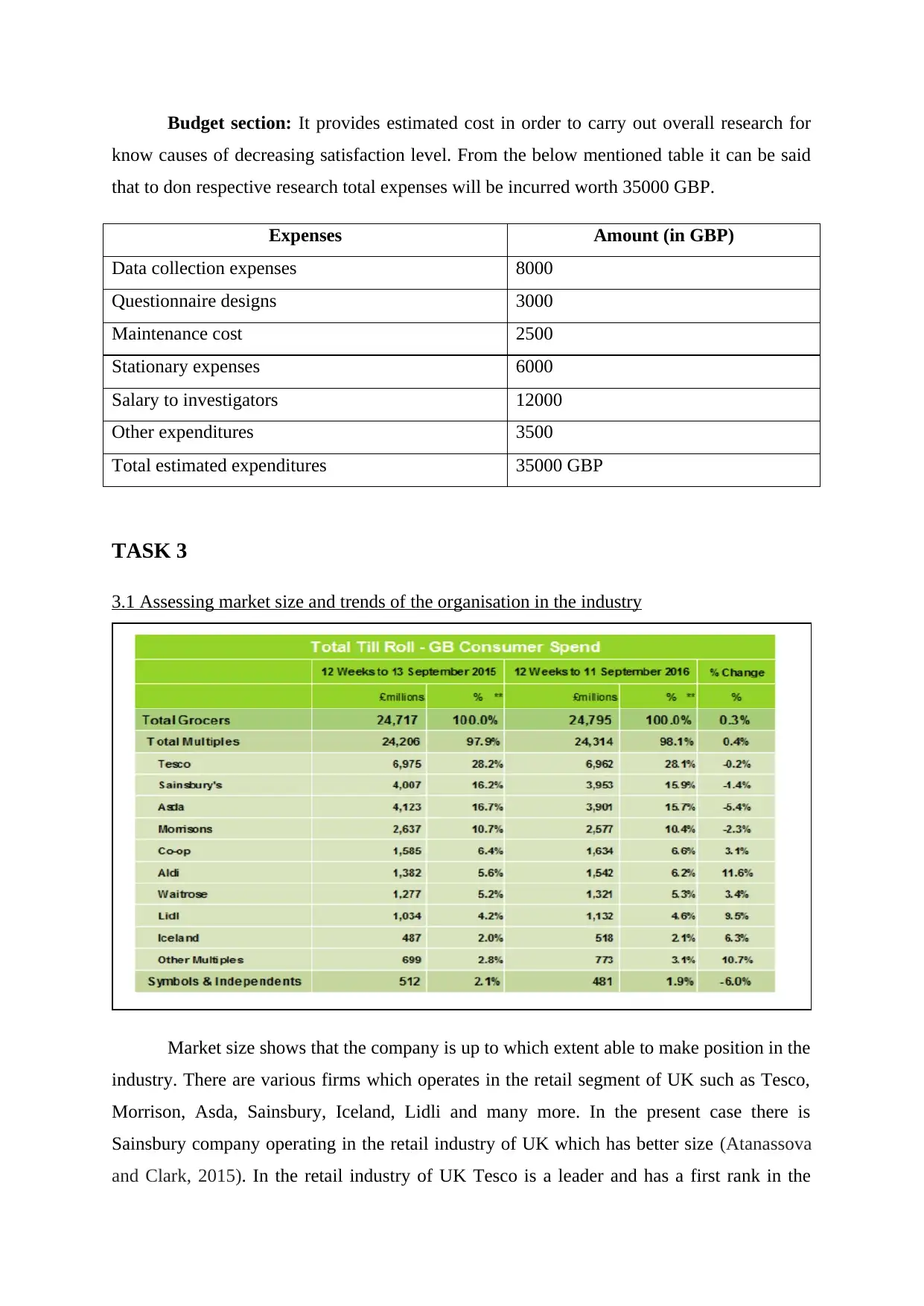
Budget section: It provides estimated cost in order to carry out overall research for
know causes of decreasing satisfaction level. From the below mentioned table it can be said
that to don respective research total expenses will be incurred worth 35000 GBP.
Expenses Amount (in GBP)
Data collection expenses 8000
Questionnaire designs 3000
Maintenance cost 2500
Stationary expenses 6000
Salary to investigators 12000
Other expenditures 3500
Total estimated expenditures 35000 GBP
TASK 3
3.1 Assessing market size and trends of the organisation in the industry
Market size shows that the company is up to which extent able to make position in the
industry. There are various firms which operates in the retail segment of UK such as Tesco,
Morrison, Asda, Sainsbury, Iceland, Lidli and many more. In the present case there is
Sainsbury company operating in the retail industry of UK which has better size (Atanassova
and Clark, 2015). In the retail industry of UK Tesco is a leader and has a first rank in the
know causes of decreasing satisfaction level. From the below mentioned table it can be said
that to don respective research total expenses will be incurred worth 35000 GBP.
Expenses Amount (in GBP)
Data collection expenses 8000
Questionnaire designs 3000
Maintenance cost 2500
Stationary expenses 6000
Salary to investigators 12000
Other expenditures 3500
Total estimated expenditures 35000 GBP
TASK 3
3.1 Assessing market size and trends of the organisation in the industry
Market size shows that the company is up to which extent able to make position in the
industry. There are various firms which operates in the retail segment of UK such as Tesco,
Morrison, Asda, Sainsbury, Iceland, Lidli and many more. In the present case there is
Sainsbury company operating in the retail industry of UK which has better size (Atanassova
and Clark, 2015). In the retail industry of UK Tesco is a leader and has a first rank in the
Paraphrase This Document
Need a fresh take? Get an instant paraphrase of this document with our AI Paraphraser
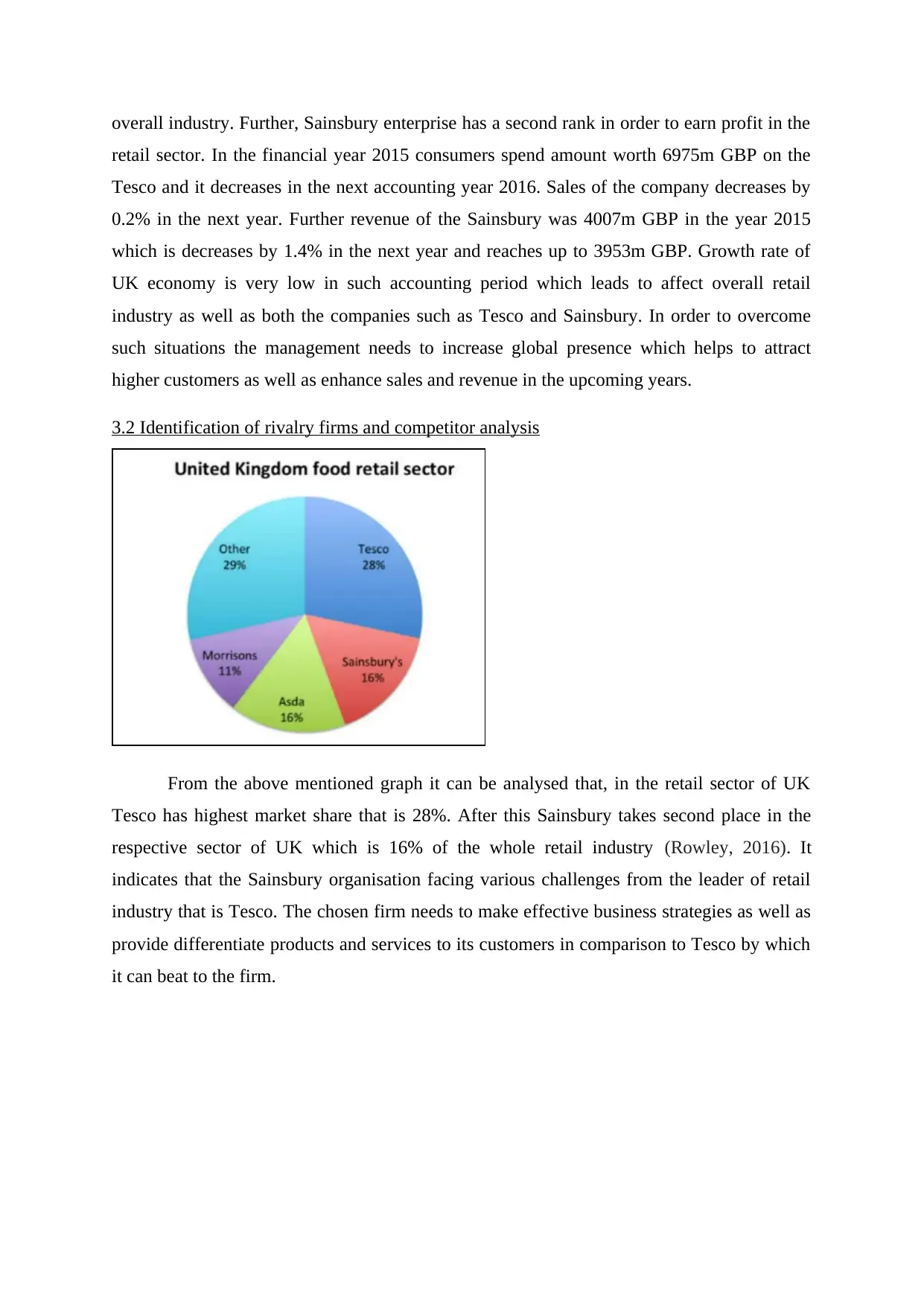
overall industry. Further, Sainsbury enterprise has a second rank in order to earn profit in the
retail sector. In the financial year 2015 consumers spend amount worth 6975m GBP on the
Tesco and it decreases in the next accounting year 2016. Sales of the company decreases by
0.2% in the next year. Further revenue of the Sainsbury was 4007m GBP in the year 2015
which is decreases by 1.4% in the next year and reaches up to 3953m GBP. Growth rate of
UK economy is very low in such accounting period which leads to affect overall retail
industry as well as both the companies such as Tesco and Sainsbury. In order to overcome
such situations the management needs to increase global presence which helps to attract
higher customers as well as enhance sales and revenue in the upcoming years.
3.2 Identification of rivalry firms and competitor analysis
From the above mentioned graph it can be analysed that, in the retail sector of UK
Tesco has highest market share that is 28%. After this Sainsbury takes second place in the
respective sector of UK which is 16% of the whole retail industry (Rowley, 2016). It
indicates that the Sainsbury organisation facing various challenges from the leader of retail
industry that is Tesco. The chosen firm needs to make effective business strategies as well as
provide differentiate products and services to its customers in comparison to Tesco by which
it can beat to the firm.
retail sector. In the financial year 2015 consumers spend amount worth 6975m GBP on the
Tesco and it decreases in the next accounting year 2016. Sales of the company decreases by
0.2% in the next year. Further revenue of the Sainsbury was 4007m GBP in the year 2015
which is decreases by 1.4% in the next year and reaches up to 3953m GBP. Growth rate of
UK economy is very low in such accounting period which leads to affect overall retail
industry as well as both the companies such as Tesco and Sainsbury. In order to overcome
such situations the management needs to increase global presence which helps to attract
higher customers as well as enhance sales and revenue in the upcoming years.
3.2 Identification of rivalry firms and competitor analysis
From the above mentioned graph it can be analysed that, in the retail sector of UK
Tesco has highest market share that is 28%. After this Sainsbury takes second place in the
respective sector of UK which is 16% of the whole retail industry (Rowley, 2016). It
indicates that the Sainsbury organisation facing various challenges from the leader of retail
industry that is Tesco. The chosen firm needs to make effective business strategies as well as
provide differentiate products and services to its customers in comparison to Tesco by which
it can beat to the firm.
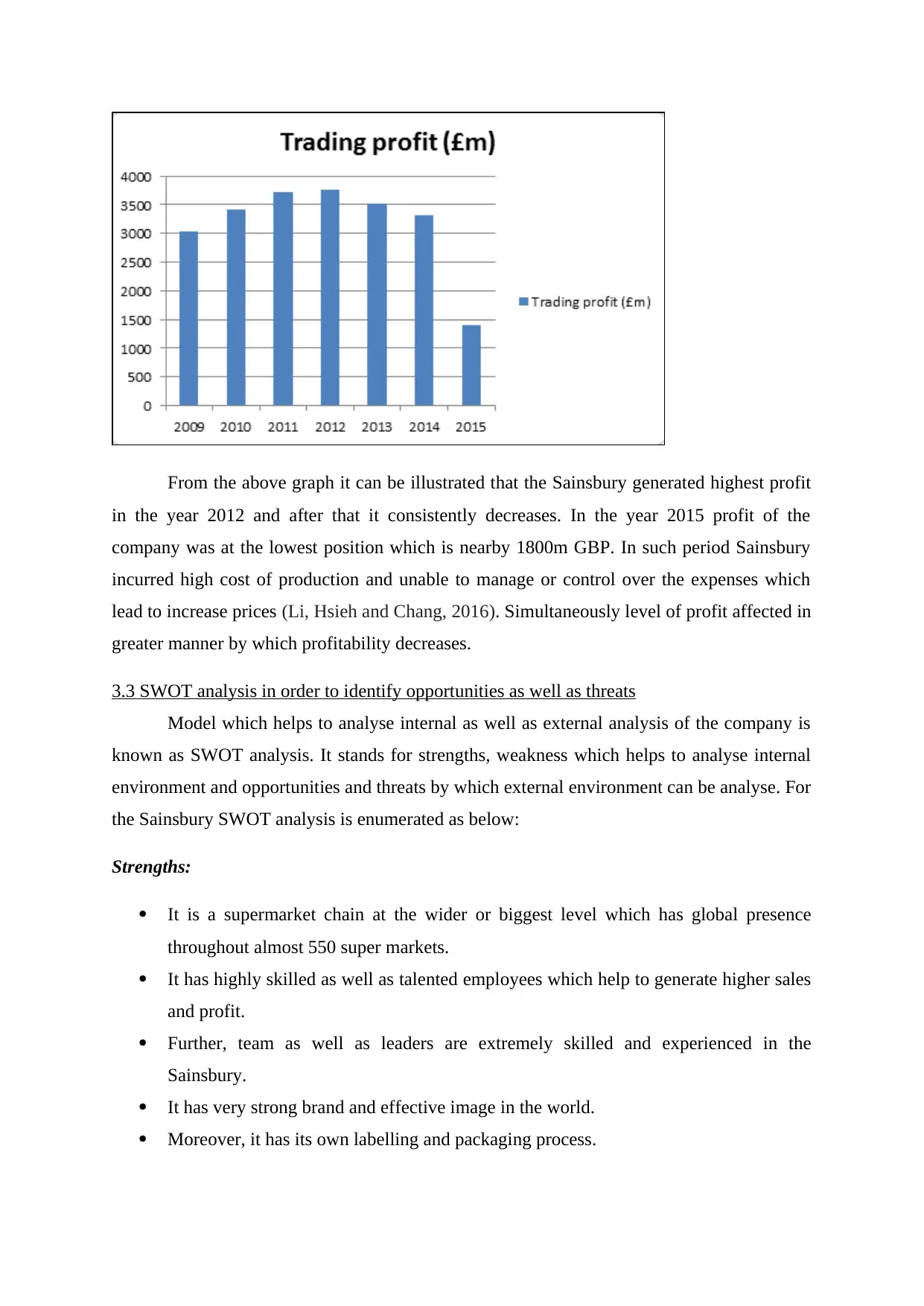
From the above graph it can be illustrated that the Sainsbury generated highest profit
in the year 2012 and after that it consistently decreases. In the year 2015 profit of the
company was at the lowest position which is nearby 1800m GBP. In such period Sainsbury
incurred high cost of production and unable to manage or control over the expenses which
lead to increase prices (Li, Hsieh and Chang, 2016). Simultaneously level of profit affected in
greater manner by which profitability decreases.
3.3 SWOT analysis in order to identify opportunities as well as threats
Model which helps to analyse internal as well as external analysis of the company is
known as SWOT analysis. It stands for strengths, weakness which helps to analyse internal
environment and opportunities and threats by which external environment can be analyse. For
the Sainsbury SWOT analysis is enumerated as below:
Strengths:
It is a supermarket chain at the wider or biggest level which has global presence
throughout almost 550 super markets.
It has highly skilled as well as talented employees which help to generate higher sales
and profit.
Further, team as well as leaders are extremely skilled and experienced in the
Sainsbury.
It has very strong brand and effective image in the world.
Moreover, it has its own labelling and packaging process.
in the year 2012 and after that it consistently decreases. In the year 2015 profit of the
company was at the lowest position which is nearby 1800m GBP. In such period Sainsbury
incurred high cost of production and unable to manage or control over the expenses which
lead to increase prices (Li, Hsieh and Chang, 2016). Simultaneously level of profit affected in
greater manner by which profitability decreases.
3.3 SWOT analysis in order to identify opportunities as well as threats
Model which helps to analyse internal as well as external analysis of the company is
known as SWOT analysis. It stands for strengths, weakness which helps to analyse internal
environment and opportunities and threats by which external environment can be analyse. For
the Sainsbury SWOT analysis is enumerated as below:
Strengths:
It is a supermarket chain at the wider or biggest level which has global presence
throughout almost 550 super markets.
It has highly skilled as well as talented employees which help to generate higher sales
and profit.
Further, team as well as leaders are extremely skilled and experienced in the
Sainsbury.
It has very strong brand and effective image in the world.
Moreover, it has its own labelling and packaging process.
⊘ This is a preview!⊘
Do you want full access?
Subscribe today to unlock all pages.

Trusted by 1+ million students worldwide
1 out of 18
Related Documents
Your All-in-One AI-Powered Toolkit for Academic Success.
+13062052269
info@desklib.com
Available 24*7 on WhatsApp / Email
![[object Object]](/_next/static/media/star-bottom.7253800d.svg)
Unlock your academic potential
Copyright © 2020–2025 A2Z Services. All Rights Reserved. Developed and managed by ZUCOL.





